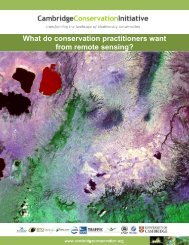CONSERVING BIODIVERSITY & DELIVERING ECOSYSTEM SERVICES
conserving biodiversity & delivering ecosystem services
conserving biodiversity & delivering ecosystem services
You also want an ePaper? Increase the reach of your titles
YUMPU automatically turns print PDFs into web optimized ePapers that Google loves.
Nature-based tourism and outdoor recreation are important activities in<br />
Nepal, underpinned by the country’s rich biodiversity and spectacular<br />
landscapes. Some of the major tourism activities are trekking, safari drives,<br />
elephant safaris, water sports, rock climbing and homestays. Protected Areas,<br />
including many IBAs, are major destinations for adventure and wildlife<br />
tourism, trekking and water-based recreation. The economic benefits from<br />
tourism and recreation are crucial for many local communities, as well as an<br />
important source of foreign currency for the Government. The Ministry of<br />
Tourism and Civil Aviation is responsible for formulating policies and<br />
strategies to promote tourism, and the new tourism policy endorsed in 2009<br />
(David Thomas)<br />
aims to develop tourism as an important agent of national development, diversifying tourism in rural and mountain areas. The<br />
Nepal Tourism Board, which was established in 1999, promotes tourism in Nepal and internationally through public-private<br />
partnership, and is working to meet the Government target to attract two million visitors by 2020 as envisaged in the Tourism<br />
Vision 2020.<br />
This study shows: Tourism and recreation is a service delivered by the majority of IBAs although some, such as Koshi Tappu<br />
Wildlife Reserve and Rara National Park, receive negligible numbers of fee-paying international tourists and are therefore not<br />
capturing the full potential benefits from this service. The anticipated increase in tourism at IBAs by 2020 is reflected in the<br />
plans of the Nepal Tourism Board to attract more visitors. Although an increase in this service can be considered positive, large<br />
increases in visitor numbers will increase the risk of disturbance unless carefully managed.<br />
Key recommendations<br />
■ Consider how increased tourism might impact on Nepal’s Protected Areas and other sites important for biodiversity<br />
conservation, and work with the Nepal Tourism Board to develop a strategy that invests more of the revenue generated<br />
(entry fees) in the conservation and management of the areas in question, ensuring that expansion is sustainable and<br />
does not compromise important biodiversity and ecosystem services<br />
■ At selected sites, develop low impact nature-based activities that provide income to local communities (local guides,<br />
local accommodation etc.)<br />
<br />
Nepal is active as a Party to the UN Framework Convention on Climate Change<br />
(UNFCCC). Relevant legislation includes the Climate Change Policy 2011, the<br />
Environment Protection Act 1996 and the Environment Protection Rules 1997.<br />
The Government body responsible for climate change and ecosystem-based<br />
adaptation is the Ministry of Environment (a specific Climate Change<br />
Management Division was established in 2010). In 2009, the Government<br />
established the Climate Change Council, under the chairmanship of the Prime<br />
Minister, to coordinate the formulation and implementation of climate<br />
change-related policies. In 2010, a National Adaptation Programme of Action<br />
(NAPA) was endorsed by the Government, leading to the development of<br />
Local Adaptation Plans of Action (LAPAs) to implement activities on the ground.<br />
(©Mathias Zehring)<br />
Nepal is included in the Carbon Partnership Facility (CPF) programme of the World Bank, with the Ministry of Forests and Soil<br />
Conservation (MoFSC) taking the lead role in implementing national activities related to REDD+. The Ministry has already<br />
submitted Nepal’s Readiness Preparation Proposal (R-PP, 2010–2013) to the World Bank, which provides a roadmap for<br />
developing and implementing the REDD strategy. The success of the REDD mechanism will depend on the availability of<br />
reliable data on forest cover and biomass changes. To build capacity in this regard, the Government has been organizing REDD<br />
orientation training in various regions of Nepal and has established a ‘REDD Cell’ (a unit within the MoFSC) which, in<br />
collaboration with other stakeholders, has prepared Forest Carbon Measurement Guidelines.<br />
This study shows: Climate change is considered a severe threat to habitats and species at a number of IBAs. Although this is a<br />
long-term driver, it is likely to alter the ability of sites to provide various services such as harvested wild goods and water, with<br />
profound impacts on local people. Climate change will also exacerbate other threats: for example, forest clearance and forest<br />
and wetland degradation will increase the incidence of flooding events from extreme rainfall.<br />
Key recommendations<br />
■ At selected sites, including those with forest and wetlands, and in the high mountains, provide support to vulnerable<br />
communities for ecosystem-based approaches for adaptation, linked to Local Adaptation Plans of Actions,<br />
demonstrating the values of using and conserving biodiversity and ecosystems to help people adapt to climate<br />
change impacts<br />
■ Coordinate and collaborate with the concerned Government ministries and departments, and the ‘REDD Cell’ to<br />
implement REDD-related activities




